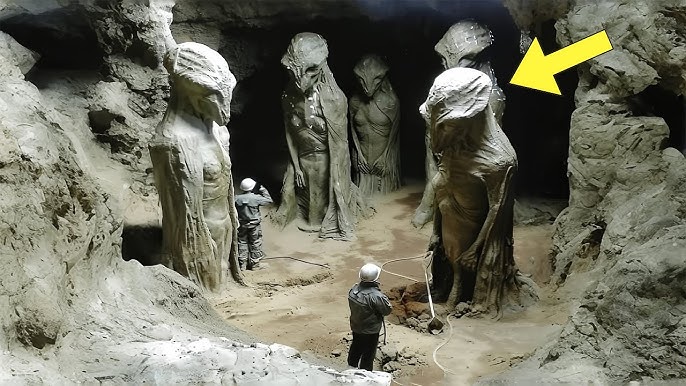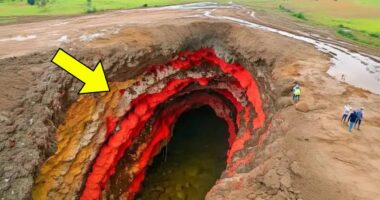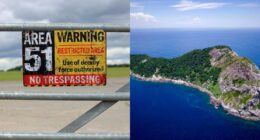In the heart of an uncharted mountainous region, far from the reach of modern civilization, a single unexpected discovery turned an ordinary weekend hike into the beginning of one of the most astonishing archaeological revelations in history. What began as a curious moment for a hiker named Alex quickly escalated into a scientific expedition of monumental proportions, uncovering secrets that could rewrite our understanding of ancient civilizations—and possibly human origins.
Alex had always been drawn to nature, and on this particular crisp morning, he set off on a trail less traveled. He didn’t expect anything beyond fresh air and breathtaking views. But as he wandered deeper into a canyon surrounded by towering cliffs, something peculiar caught his eye: a symmetrical series of engravings and structures subtly carved into the side of the mountain. As he approached, he realized these weren’t natural formations—they were the remnants of an ancient city, seemingly etched into the rock itself. Hidden from the world, the discovery was nothing short of extraordinary.
With growing excitement, Alex contacted the local authorities and a nearby university’s archaeology department. What followed was the swift assembling of an elite team of archaeologists and historians, equipped with the latest technology and brimming with curiosity. Among them were two of the most respected minds in the field: Dr. Eleanor Voss, known for her pioneering work in ancient architecture and anthropology, and Dr. Marcus Horn, a renowned skeptic celebrated for debunking pseudoscientific claims with razor-sharp logic.
Together, this team would descend into the mystery—literally.
A City Frozen in Time
As the team entered the city through its main archway—a stone doorway barely visible from the surface—the air shifted. The temperature dropped slightly, and the light dimmed as the towering rock walls surrounded them. The narrow corridors gave way to sprawling chambers filled with intricate carvings, astonishing in both detail and scale. Symbols adorned every surface—walls, pillars, even the ceilings—many of which were unlike anything recorded in known ancient cultures.
What baffled the team was not only the size of the city but the sheer sophistication of its design. Ventilation shafts, water channels, and interconnected rooms suggested a level of urban planning far beyond what they had expected. And the city was untouched. No signs of looting. No evidence of other explorers. It was as though time had sealed it away, preserving every detail for this moment.
But it wasn’t long before something felt… off.
The Unease Beneath Discovery
As they ventured deeper into the city, a heavy stillness settled around them. The team’s initial enthusiasm turned to hushed curiosity. Conversations slowed, replaced by the faint echoes of their own footsteps. Shadows seemed to linger too long in the corners of the chambers. Some members reported feeling watched. The excitement of discovery was slowly being replaced by an eerie sense that they weren’t alone.
That suspicion was amplified when they began encountering booby traps—mechanisms that activated under pressure, narrow passageways rigged with collapse triggers, and hidden spikes. Whoever built this city wanted to keep something inside… or keep others out.
The Artifacts That Shouldn’t Exist
Despite the danger, the team pressed forward, drawn by the city’s mysteries. They began unearthing artifacts that left even the most skeptical of researchers stunned. Tools forged from unknown metals, gears with microscopic engravings, and devices that appeared mechanical in function but predated any known invention by thousands of years. Some artifacts radiated a faint warmth, while others emitted subtle electromagnetic pulses. These weren’t relics—they were technologies.
Dr. Horn, ever the doubter, was forced to confront his disbelief. “This shouldn’t be possible,” he muttered more than once as he analyzed the strange machinery. “If this is real, it changes everything.”
And that was before they discovered the mural.
The Mural of the Sky People
Carved into the wall of what appeared to be a grand ceremonial chamber was an expansive mural. It depicted humanoid figures interacting with beings that descended from the sky. These “sky people” were shown sharing knowledge—depicted in beams of light and spirals of symbols—with the ancient inhabitants. The beings were unlike any earthly creature. Tall, elongated heads. Large, expressive eyes. Always hovering, never grounded.
Could this be a mythological record of something more?
The team debated fiercely. Some claimed it was symbolic—a representation of divine enlightenment. Others, like Dr. Voss, argued that it might point to a forgotten event in human history. “We’re trained to dismiss what doesn’t fit into our framework,” she said, “but sometimes you have to entertain the impossible to find the truth.”
The Door and the Bones
Their path eventually led to a sealed chamber, its entrance guarded by a giant stone door engraved with the same symbols seen in the mural. At its center, an indentation perfectly matched the shape of a medallion they’d found earlier.
With cautious reverence, they placed the medallion into the groove. The door trembled, then slowly creaked open, revealing a chamber unlike any they had seen before.
Inside lay skeletal remains, preserved in ceremonial repose. But these were not human. The skull was elongated, the limbs longer than natural proportions. It didn’t match any known species. The bones were arranged deliberately, surrounded by glowing crystals and intricate etchings. This was not just a burial—it was a shrine.
Was this the resting place of one of the “sky people”?
Theories exploded among the team. Some proposed an undiscovered human ancestor. Others believed this could be proof of contact with a non-human intelligence. Either way, it was unprecedented.
Journals From Another Time
Then came the most shocking discovery of all: journals. Dozens of stone tablets inscribed with scripts that, when decoded, revealed details of life in the ancient city. They spoke of scientific breakthroughs, advanced engineering, and philosophical insights. Most astonishing were the descriptions of catastrophic events—plagues, floods, and “the great silence,” a sudden end to communication with the sky beings.
One passage stood out:
“The lights in the sky stopped returning. We were left with their gifts, but without guidance. Now we wait, hoping they return before the end.”
It was both poetic and haunting.
Inner Conflicts and World-Changing Truths
Tensions ran high. The team was torn between their desire to share the discoveries and fear of the implications. If this city was revealed, it could challenge fundamental beliefs, rewrite historical timelines, and trigger global debates about human origin and extraterrestrial contact.
Dr. Horn, who once scoffed at fringe theories, now stood at the front of the team’s documentation efforts, meticulously recording every detail. “We owe it to humanity to preserve this,” he said.
Meanwhile, Dr. Voss became increasingly convinced that the city was part of a global network—possibly one of many—and urged caution and deeper study before exposure.
The Living Energy
In a central laboratory, they discovered something that defied logic: a still-active energy field. Devices flickered when near it. Instruments malfunctioned. When Dr. Voss placed her hand near the field, she described a tingling sensation—like a frequency vibrating just beyond human perception.
Dr. Horn suggested testing it with electromagnetic pulses. Cautiously, they used modern techniques to interact with the field. It pulsed back. Not violently—but like a response.
Was it alive? Was it waiting?
Whatever it was, it proved that some of the city’s technology still functioned—thousands of years later.
The Decision to Reveal
After weeks of exploration, endless debates, and countless discoveries, the team reached a consensus. The world needed to know. They carefully compiled evidence: 3D maps, digital scans, photos, and journal transcriptions. But they also knew the information had to be released responsibly.
Dr. Voss and Dr. Horn led the effort to present their findings to the academic community and media. The release caused an uproar. Some hailed it as the greatest discovery in human history. Others denied its authenticity. Governments requested further investigations. Debates raged.
But one thing was clear: history had changed.
Legacy of the Lost City
Alex, the hiker who found the city, returned months later. Where once there was silence and stone, now there were researchers, journalists, and guarded pathways. But the magic of that first discovery still lingered in the air.
The ancient city had revealed more than secrets—it had sparked a movement. A deeper curiosity about what else might lie hidden beneath the earth, waiting for the right eyes to find it.
As humanity looked to the stars, they also began looking inward—into the ground, into history, and into themselves.
Because sometimes, the greatest truths are buried not in the sky—but in the silence of stone.







